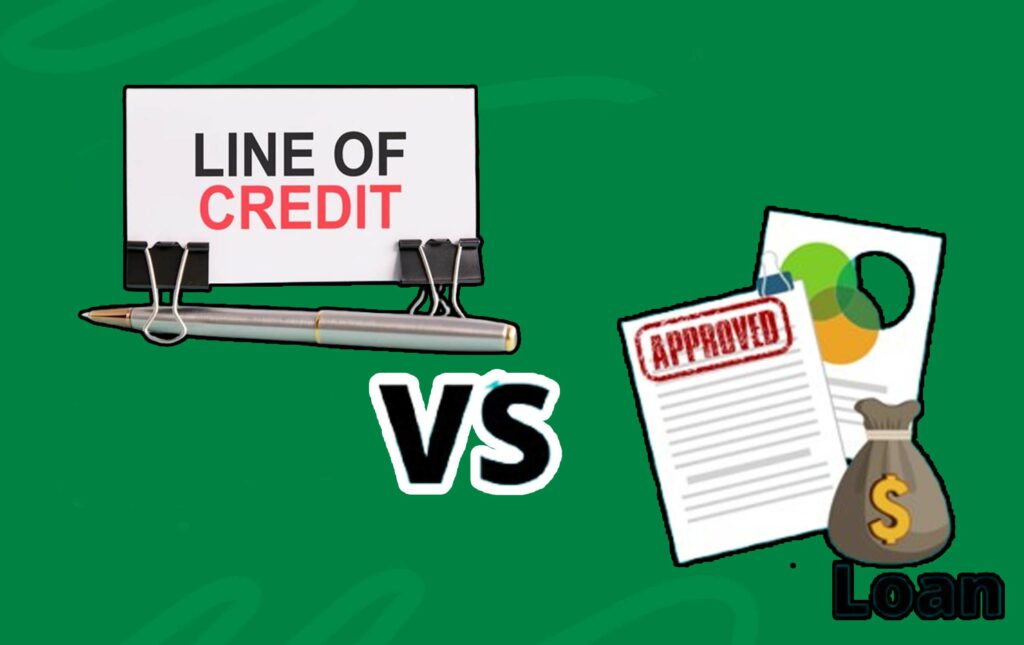Loan vs. Line of Credit: What’s the Difference- It can be quite daunting navigating your way through the realm of borrowing, specifically if you come across options such as loans and lines of credit. Firstly, both are financial tools that provide borrowers access to funds, but they are also different in their unique ways.

In the meantime, it is essential that you understand these differences, leading to one of the most asked questions by borrowers: loan vs. line of credit—what’s the difference? If you need the answer to this question, the explanation you need will be available in this guide. We will also be discussing the types, pros and cons of taking them out, and when to and not to take them out.
What is a Loan?
A loan is a financial transaction between a borrower and a lender. So, the lender provides assets and money to the borrower on the condition that the borrower will pay back the money as well as the agreed-on interest fees within a fixed period.
Types of Loans
There are different types of loans, and they include
- Personal loans.
- Auto loans.
- Secured loans.
- Mortgage loans.
- Unsecured loans.
- Student loans.
- Credit builder loans.
- Business loans.
- Debt consolidation loans.
- Payday loans.
Pros and Cons
Here are the advantages and disadvantages of applying for a loan:
Pros
- Making important purchases is possible.
- Instant access to funds.
- Achieving long-term financial goals is possible.
- Credit score-improving tools.
- Emergencies and unexpected expenses are covered.
- Competitive interest rates.
- Provides liquidity.
- Such rates have the potential to stimulate financial growth.
- Tax benefits.
- Repayment terms flexibility.
- Liquidity.
Cons
- High-interest rates.
- Hidden penalties and fees.
- Accrued interest.
- Collateral required.
- Limited financial flexibility.
- Negative impact on credit score if a borrower defaults.
- Asset seizure and legal actions if a borrower defaults.
- Economic fluctuations.
- Prevent long-term financial stability.
When to Consider a Loan
Here are the suitable times to take out or apply for a loan:
- Asset investment.
- Seizing business opportunities.
- Cover emergency expenses.
- Debt consolidation.
- Credit-building opportunities.
- Necessary financial purchases.
- If you can afford to cover it.
- Facing financial difficulties.
- Self-investment.
When To Not Consider One
It is ideal to take out a loan if:
- The interest rates are too high.
- If unimportant purchases can be postponed.
- If you want to finance a risky investment that does not have fixed returns.
- When there are available alternative sources of funding.
- If you do not have enough income or a clear repayment plan.
- If the loan terms come with predatory practices.
- Poor credit history and financial situation can make approval impossible.
When taking out a loan can make existing debt situations worse.
What is a Line of Credit?
A line of credit is also known as an LOC, and it is a flexible borrowing plan provided by financial institutions, enabling businesses and individuals to access funds up to a particular amount or limit. What’s more, with a line of credit, you can get funds up to a predetermined limit and pay interest on the amount you used up, unlike traditional loans where you get a lump sum upfront.
Types of Lines of Credit
There are different types of lines of credit, and they include
- Business line of credit.
- Personal line of credit.
- Unsecured line of credit.
- Home equity line of credit (HELOC).
- Secured line of credit.
- Securities-backed line of credit (SBLOC).
- Demand a line of credit.
- Student line of credit.
Pros and Cons
These are the advantages and disadvantages of applying for a line of credit:
Pros
Quick access.
- Flexibility.
- Credit building.
- Interest only on the amount used.
- Lower interest rates.
- Potential tax deductions.
- Financial safety net.
- Revolving credit.
Cons
- Potential fees.
- Market dependency.
- Variable interest rates.
- Credit score impact.
- Complex terms.
- Risk of overborrowing.
- Dependency.
- Collateral requirement.
- Credit limit changes.
- Limited use.
When to Consider a Line of Credit
- It is a good idea to opt for a line of credit if you need:
- Emergency fund.
- Consolidate your debt.
- Short-term financing.
- Business expenses.
- Home renovations.
When To Not Consider One
It is not advisable to apply for a line of credit under any of these circumstances:
- Uncertain investments.
- Inability to pay back.
- Unnecessary Expenses.
- If you do not have enough cash flow.
- High debt responsibilities.
- Have reckless spending habits.
Loan vs. Line of Credit: What’s the Difference?
Here are some of the differences between a loan and a line of credit. With this table, you will have an understanding of how to compare both financial tools. Now, let’s begin:
| Aspect | Loan | Line of Credit |
| Purpose | Usually for specific purposes | Usually for different purposes |
| Nature | A lump sum of money | Credit limits with access to funds |
| Interest | Applied to the whole loan amount | Applied to the amount borrowed only |
| Security | Secured or unsecured | Secured or unsecured |
| Revolving Credit | Not considered | Considered |
| Interest Rates | Variable or fixed | Usually variable |
| Repayment | Fixed | Flexible |
| Term | Fixed | Unfixed |
| Access to Funds | Funds are received in one disbursement | Funded need to be up to a particular credit limit |
| Risk of Overborrowing | High possibilities | Low possibilities |
With this table, you now know the major differences between lines of credit and loans and will have no problem choosing the best option for your needs.



